
Blazing Trails in Biomass Use
May 28, 2009
By Jean Sorensen
“We have blazed a lot of trails here,” says Wayne Mercer, Western
Canada manager of fibre supply for Tembec, an integrated forest
products company.
“We have blazed a lot of trails here,” says Wayne Mercer, Western Canada manager of fibre supply for Tembec, an integrated forest products company. He is talking about Tembec’s hog fuel program to feed its Skookumchuck, BC, co-generation plant 800 green tons of ground biomass daily. The plant powers Tembec’s pulp mill with 26 megawatts of power; another 10 megawatts goes into BC Hydro’s grid.
 |
|
| A Peterson chipper works at Tembec’s Canal Flats log yard, where low grade material is salvaged.
|
The original reason for firing the co-generation plant was to use sawmill waste, says Mercer. However, in 2004, a short-term need caused the company to acquire a grinder for bush biomass. “We acquired one grinder on the basis that we would use it for 1000 to 1200 hours per year,” he says. Since then, the program has expanded, spurred in part by the recent closure of sawmills because of the U.S. downturn. “We have four grinders working fairly steadily. Each is working about 1400 hours per year,” says Mercer. And another two are being added.
“It has really come on in the last 18 months,” agrees Brian Edeburn, who is in charge of Tembec’s hog fuel program and is responsible for finding new biomass streams. “The hog fuel program now is as large as the chip program.” This need to find new sources of hog fuel has resulted in the discovery of a number of opportunities in the Cranbrook timber supply area and surrounding areas.
Right now, says Edeburn, Tembec operations are landing all the debris that can be reasonably yarded to the roadside on normal cuts—stumps, chunks, undersized wood, slash, and tops. In special areas such as those used for ecosystem restoration, land clearing, and fire interfaces, debris taken from the site is free of charge.
“Look at this area,” says Edeburn as his pick-up rumbles by private lands just outside Canal Flats that have been cleared to allow grassland growth. He points to wood heaped in burn piles throughout the site. “If they had dragged it into a landing area, we could have brought in a portable grinder and used it.” Now, the wood is sitting in piles and waiting for several clear days so it can be burned.
 |
|
| Vermeer operator Tim Bartlett with Tembec’s Brian Edeburn and some of the operation’s hog fuel. |
There are restrictions on open burning around towns such as Cranbrook, Kimberley, Fernie, and Elko. “You have to have two good days of burning,” says Edeburn. The bottom line: no smoke can blow into the towns. Greater restrictions on burning are a trend that Edeburn sees continuing with the development of policies to reduce carbon emissions.
Out by Cranbrook Airport, Edeburn shows off another source of hog fuel and chips. The interface area ringing the airport has been logged. It looks park-like, with stems spaced apart throughout and understory removed. From an aircraft, the view of the forest is noticeably different from the other surrounding stands, says Edeburn.
The sawlogs are removed, and pulpwood from this and other sites is taken to one of Tembec’s three chipping stations: Canal Flats, Elko, and a private mill in Mardis. Tembec uses two Peterson 5000 chippers and moves them among the three locations, says Ron Hrisook, pulp and chip supply manager. The pulp logs also provide some hog fuel material because waste from the chippers is re-ground. “Rat-tails,” or spindly tops that increase bark content, are often removed from pulpwood and sent to the grinders.
After the logs have been removed and the piles of debris have cured for a year to reduce the moisture content, portable chippers are brought to the material. The debris piles can measure 150 feet in length, 40 feet wide, and 15 feet high. Ideally, the stacks should contain at least 15 to 20 loads [of ground material], says Edeburn.
One such location is Lower Mark Creek, where Tembec contractor Prairie Holdings logged the area a year ago. Cured material is awaiting the grinder. Tim Bartlett, who runs the stationary grinder – a tracked horizontal Vermeer 6000 – is at the site. But there’s a glitch. It’s the major problem plaguing most logging operations in the Kootenays: there is an acute shortage of truck drivers. Most trucking companies have trucks sitting idle, the drivers having left the industry to work the nearby coalmines, says Edeburn. “It seems no one wants to work the hours any more.”
 |
|
| The Vermeer 6000 runs a demo for Canadian Biomass magazine.
|
This glitch extends into the bush. Highway chip trucks, which carry 17 to 18 bone dry units (BDU) in a walking floor unit or up to 22 to 23 BDU in a larger 53-foot unit, require experienced logging truck drivers to navigate the narrow forest roads. Ensuring that the roads can accommodate the large, loaded trucks is a major concern. ”About a 15 to 17 per cent slope is as much grade as the trucks can handle,” says Edeburn. According to Brian Dureski, Tembec’s planning supervisor for Kootenay Central, this now is a consideration when laying out roads in cut blocks that generate biomass, and roads are looped around so that drivers don’t have to back up or find an area to turn around.
Tembec has been experimenting with various grinder models over the years to “see what kind of machine works best,” says Edeburn. He says there are some advantages to the tracked unit because the remote controls allow independent movement along an extended pile. Bartlett runs the tracked grinder via remote control, and also doubles on a small Cat that is used to groom the roads or on one of the two pieces of equipment that works with the Vermeer 6000.
A Cat 966 wheel loader is used to feed biomass over to the Cat 320 excavator, which lifts it to the Vermeer 6000. “You get a lot of rocks in the material,” notes Edeburn. “When you dump it, you can spin it around and see what is in the load.” That is what the excavator operator will do to ensure that only material for hogging goes through the grinder. The excavator head can also be used to break larger wood
pieces.
Edeburn says that the company’s other older Vermeer is a wheeled unit that is currently stationed in the pulpwood yard at Canal Flats. It is used to handle debris, bark from the chipper, and smaller tops from pulp logs that are snapped off to reduce the bark content in the chipper. The wheeled Vermeer has been adapted with a higher conveyor to reach the trucks, and they rely on the throwing power of the one in the forest to toss the hog fuel into the truck.
Tembec’s fleet of grinders is supplemented by hiring contractors such as Chatter Creek Holdings out of Golden, BC, which uses a Morbark tub grinder and a recently acquired Peterson Pacific on tracks, says Edeburn.
“We are providing a clean-up service,” says Mercer in describing the role that Tembec is playing. Tembec does not pay for the biomass it grinds, but pays for the grinding and transportation costs. If it is a licensee’s waste that is being picked up, it’s already accounted for in the waste assessment. Whether it is from private or public lands, savings are accrued by the client in eliminating the cost of burning.
Even though the biomass is free, a strong determinant of whether this type of biomass recovery works is the cycle time for trucks from the pulp mill to the landing. “Anything over six hours, we really have to look at,” says Edeburn.
On lands that Tembec or its contractors are logging, a major consideration is the mixed value of the wood. Sawlogs need to account for 50 per cent of the volume. And the pulp market has to be strong enough to be able to make the pulpwood worthwhile. Both agree that simply shunting the pulpwood into hog fuel would not make a logging venture viable.
The good pulp market through most of 2007 allowed Tembec to go into ecosystem restoration areas. Tembec has obtained nonrenewable forest licenses for some of these areas, and they are a biomass bonus for the company, says Dureski. The additional fibre accrued did not come off the company’s annual allowable cut.
Dureski is particularly proud of areas known as Airport Pasture (logged by Prairie Holdings) and Deacon Hills (logged by HX Logging). These are part of a restoration project in which thick stem growth due to fire
suppression had choked out traditional grassland used by wildlife and cattle for grazing. Airport Pasture has been returned to open pasture, and Deacon Hills is now open forest that will be logged selectively in the future. Working these areas has contributed to Tembec’s knowledge of how to best recover biomass.
The most effective means of biomass recovery is to centralize the piles as much as possible, rather than dot them along the roadside, says Dureski. He knows that this is added work. He states that maybe in the future, contractors will have to pay a nominal amount of yarding on the biomass on this kind of restoration work, rather than just on pulpwood and sawlogs.
These lower bottomlands, which were once large swaths of grassland habitat, are also home to the American badger, an endangered species, says Dureski. A staff biologist had identified the active dens by marking trees. That served the feller buncher, says Dureski, but there was concern that the skidders, working during spring, would compact the grounds where the mothers and their kittens were burrowed. So the trees around the burrows were stumped up to six feet, forming a guard and alerting the skidder operator. This also has downstream benefits, allowing the easy location of the dens for other purposes such as monitoring and during grassland burning.
Dureski maintains that the deployment of a mechanical harvesting crew on these lands makes better economic sense than sending in a hand crew to take down trees and slash the area manually. A mechanical crew can do up to five acres a day, he estimates. As well, the skidder can run over many of the smaller trees and prevent their growth. “Once you remove the canopy, the younger ones will spring up again,” he says. Fires afterward can prevent tree growth and rid the area of old grass.
Once the sawmills re-start, Mercer doesn’t count out the use of bush biomass, but says that “sawmills will always have priority” because the company is performing a waste disposal service to them. But he cautions that there is growing competition for sawmill waste, and more sawmills are now trying to use their waste to run dry kilns.
“Sawdust and shavings, which used to be considered a waste product for sawmills, are now being considered valuable. Sawmills are generating energy from them and they are trading the chips for hog fuel. So the supply of what was waste wood at mills is shrinking,” says Mercer.
“We will be grinding forever.”
Print this page